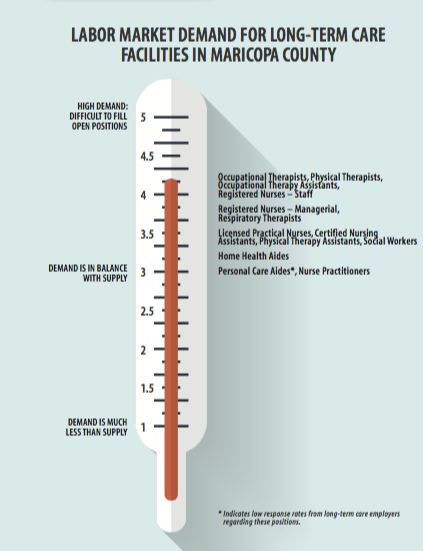UCSF conducted the Survey of Health Care Employers in Arizona: Home Health Agencies, 2015 in the summer and fall of 2015. The survey elicited 25 unique responses, representing 11.4% of the total number of home health agencies in Arizona. Yuma, Gila, and Pinal Counties were not represented in this survey, since fewer than two responses were obtained for these counties. The survey found that there is a perception of shortage for many occupations, with the greatest concern regarding physical and occupational therapists, physical and occupational therapy assistants, respiratory therapists, registered nurses, and social workers.
Positions with the MOST CONSISTENT reports of high demand include: 
- OccupationalTherapists
- Physical Therapists
- Occupational Therapy Assistants
Respondents report a MODERATE TO HIGH demand for:
- Registered Nurses – Staff
- Registered Nurses–Managerial
- Licensed PracticalNurses
- Home Health Aides
- Certified Nursing Assistants
Supply and demand were BALANCED for:
- Licensed Practical Nurses
- Home Health Aides
Positions with over 10% vacancy rate:
- RegisteredNurses – Managerial
- CertifiedNursingAssistants
- PersonalCareAides
- PhysicalTherapyAssistants
- OccupationalTherapists
- SocialWorkers
Positions with over 20% vacancy rate:
- Occupational Therapy Assistants
- Respiratory Therapists
- Staff Registered Nurses
Concern for the future
Labor market conditions faced by Arizona home health agencies indicate shortages in many occupations, including staff RNs, physical therapists, occupational therapists, physical and occupational therapy assistants, respiratory therapists, and social workers. Home health agencies expect employment increases for every occupation over the next three years. Some agencies are investing in their workforce through tuition reimbursement, and a small number offer nurse residency programs in collaboration with nursing education programs. Nearly one-third expect to develop new job classifications in the next two years, with new classifications primarily related to care coordination and management.
Agencies expressed concern about the impact of reimbursement levels dropping, potential state budget cuts to Medicaid, and the behavioral needs of their patients on the adequacy of their workforce. Home health agency leaders will need to work closely with local and state educational institutions, policymakers, and business leaders to address these concerns. Furthermore, they should develop strategies to improve their employees’ knowledge of how to manage behavioral health issues.